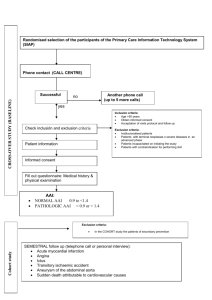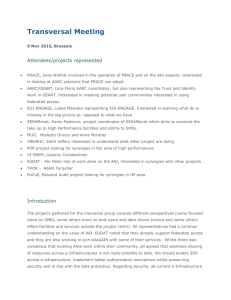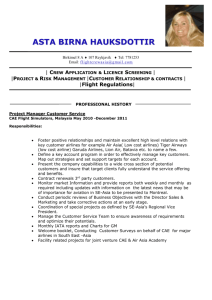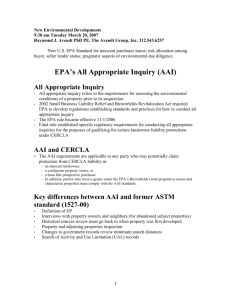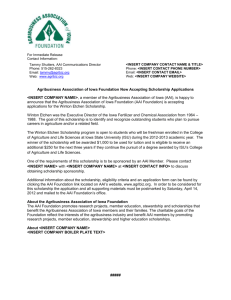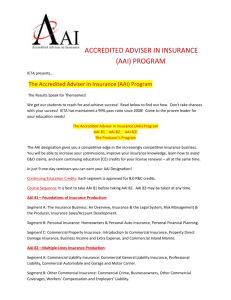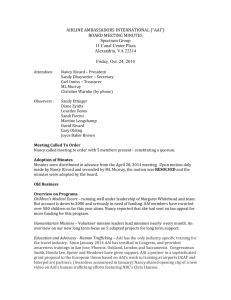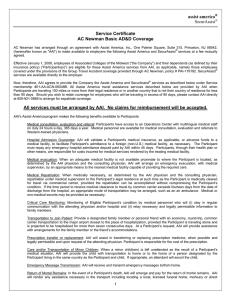Advanced Academics Curriculum Advanced Academics' (AAI
advertisement
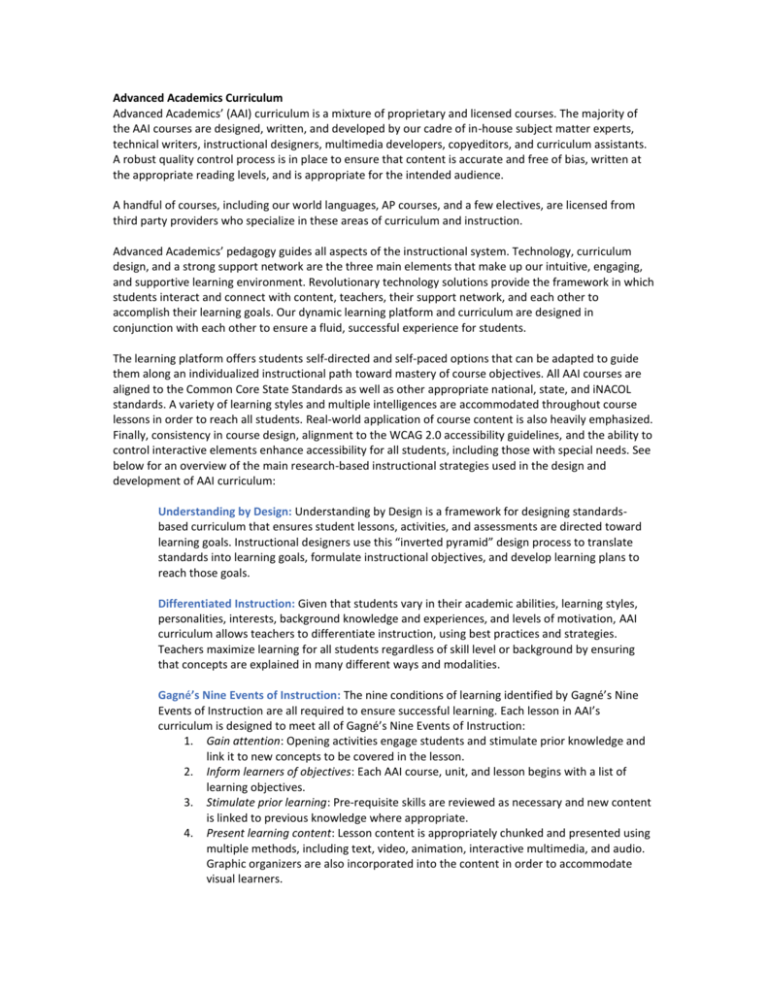
Advanced Academics Curriculum Advanced Academics’ (AAI) curriculum is a mixture of proprietary and licensed courses. The majority of the AAI courses are designed, written, and developed by our cadre of in-house subject matter experts, technical writers, instructional designers, multimedia developers, copyeditors, and curriculum assistants. A robust quality control process is in place to ensure that content is accurate and free of bias, written at the appropriate reading levels, and is appropriate for the intended audience. A handful of courses, including our world languages, AP courses, and a few electives, are licensed from third party providers who specialize in these areas of curriculum and instruction. Advanced Academics’ pedagogy guides all aspects of the instructional system. Technology, curriculum design, and a strong support network are the three main elements that make up our intuitive, engaging, and supportive learning environment. Revolutionary technology solutions provide the framework in which students interact and connect with content, teachers, their support network, and each other to accomplish their learning goals. Our dynamic learning platform and curriculum are designed in conjunction with each other to ensure a fluid, successful experience for students. The learning platform offers students self-directed and self-paced options that can be adapted to guide them along an individualized instructional path toward mastery of course objectives. All AAI courses are aligned to the Common Core State Standards as well as other appropriate national, state, and iNACOL standards. A variety of learning styles and multiple intelligences are accommodated throughout course lessons in order to reach all students. Real-world application of course content is also heavily emphasized. Finally, consistency in course design, alignment to the WCAG 2.0 accessibility guidelines, and the ability to control interactive elements enhance accessibility for all students, including those with special needs. See below for an overview of the main research-based instructional strategies used in the design and development of AAI curriculum: Understanding by Design: Understanding by Design is a framework for designing standardsbased curriculum that ensures student lessons, activities, and assessments are directed toward learning goals. Instructional designers use this “inverted pyramid” design process to translate standards into learning goals, formulate instructional objectives, and develop learning plans to reach those goals. Differentiated Instruction: Given that students vary in their academic abilities, learning styles, personalities, interests, background knowledge and experiences, and levels of motivation, AAI curriculum allows teachers to differentiate instruction, using best practices and strategies. Teachers maximize learning for all students regardless of skill level or background by ensuring that concepts are explained in many different ways and modalities. Gagné’s Nine Events of Instruction: The nine conditions of learning identified by Gagné’s Nine Events of Instruction are all required to ensure successful learning. Each lesson in AAI’s curriculum is designed to meet all of Gagné’s Nine Events of Instruction: 1. Gain attention: Opening activities engage students and stimulate prior knowledge and link it to new concepts to be covered in the lesson. 2. Inform learners of objectives: Each AAI course, unit, and lesson begins with a list of learning objectives. 3. Stimulate prior learning: Pre-requisite skills are reviewed as necessary and new content is linked to previous knowledge where appropriate. 4. Present learning content: Lesson content is appropriately chunked and presented using multiple methods, including text, video, animation, interactive multimedia, and audio. Graphic organizers are also incorporated into the content in order to accommodate visual learners. 5. 6. 7. 8. 9. Provide guidance for learning: Scaffolding is built into all AAI courses through the use of examples and non-examples, case studies, and analogies. In addition, learning and reading strategies, such as mnemonics, are taught. “Think and Click” activities are also incorporated throughout AAI courses to encourage metacognition and synthesis. Elicit performance: AAI courses include a variety of ungraded practice opportunities as well as graded assessments such as homework assignments, discussion threads, oral assignments, papers, and projects. Students are also encouraged to engage in chat and phone conversations with AAI teachers and participate in discussions on class blogs. Provide constructive feedback: AAI courses include assessments that provide immediate feedback to students, as well as manually-graded assessments that AAI teachers grade by hand. For these manually graded assessments, AAI teachers provide specific, constructive feedback for students at both the assessment level and the individual question level. Teachers also provide feedback to students through our one-on-one internal chat system and interactive whiteboard. Assess performance: Regular assessment throughout each course is offered in the form of homework assignments, vocabulary tests, discussion threads, papers, and projects. Enhance retention and transfer: Real-world examples and application of course content to generalized situations are provided throughout AAI courses in order to encourage retention and transfer. Bloom's Taxonomy: Bloom’s Taxonomy is a hierarchal system of classifying learning objectives and tasks from basic knowledge levels to the highest level, which encourages students to become independent thinkers who take an active role in learning. This taxonomy provides curriculum developers with a structured method for ensuring that students develop higher-order thinking skills. Students are assessed at every level of Bloom's, but the focus is on higher levels to ensure complete comprehension. One additional significant key to student success is our strong support network. Our students are not confined to the timeframe and structures of a traditional classroom. Certified teachers and teaching assistants are available to help students 24/5, and technical support is available 24/7. Students can “raise their hands” and ask questions through live chat with online teachers, or call in and receive help over the phone. In this expanded learning community, a network of teachers, technical support staff, counselors, and student coaches tracks student progress and works with parents and school districts to implement strategies for student success. Every element of the AAI instructional system is carefully designed and structured to lead students to the successful achievement of their learning goals. Student success rates are monitored throughout a student’s enrollment in courses. Teachers meet with curriculum developers to discuss these success rates and how they can be improved. Quantitative and qualitative data is examined to determine the effectiveness of the courses over time. This information is used in conjunction with informal anecdotal data to assess course effectiveness. In addition, courses are evaluated on a three to five year basis. Data such as student feedback, surveys, success rate data, Texas TEKS, and iNACOL standards are used to make improvements to courses. Stakeholders such as students, teachers, instructional designers, and curriculum developers are consulted about course effectiveness and possible enhancements to content and presentation. Using the course evaluations, as described above, curriculum is updated on an ongoing basis. Any updates and/or corrections to content can be made in the live courses so they have an immediate effect on student success. Aside from ongoing updates, core courses are evaluated and revised on a regular threeyear cycle and/or when associated standards are updated. All core high school courses are NCAA approved, align to iNACOL’s Standards for Quality Online Courses, and the Common Core State Standards where appropriate.
